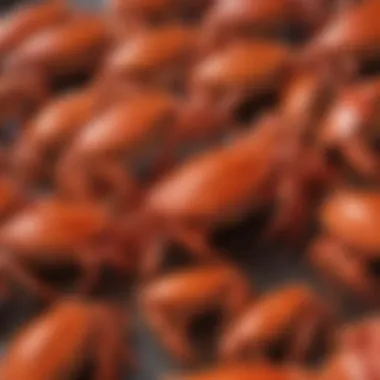Understanding the Carbohydrate Content in Imitation Crab


Intro
Imitation crab, often appeared in sushi rolls and seafood salads, is a product that intrigues many. Given its widespread use, understanding its carbohydrate content and defining characteristics becomes essential for informed dietary choices. This guide delves into the nuances of imitation crab, unearthing its ingredients and the methods of its production.
Moreover, comparing imitation crab with traditional crab meat reveals important insights into their nutritional differences and health implications. As a convenient alternative for busy lifestyles, imitation crab offers appealing options for those looking to maintain dietary balance without extensive meal preparation. Understanding this can empower culinary enthusiasts as they craft quick meals rich with flavor yet conscious of nutritional value.
Everyone should have access to knowledge about what they consume. This article aims to break down these complexities regarding imitation crab and its carbohydrates; paving the way not only for educated choices but also for enhanced culinary experiences.
Recipe Overview
Crab-Stuffed Avocado Salad
Yields: 4 portions
Prep and Cook Time: 15 minutes total
Difficulty: Easy
Main Ingredients:
- 1 cup of imitation crab meat
- 2 ripe avocados
- 1/2 cup diced cucumber
- 1/4 cup finely chopped red onion
- 2 tablespoons mayonnaise
- Salt and pepper to taste
- Lime juice for garnish
In this recipe, the balance of fresh ingredients complements the imitation crab's mild flavor effectively. The creamy avocado paired with crustacean nuances offers not only a snack but also a responde to the craving for seafood. This salad is light yet packed with nutrients, and the ease of preparation allows any culinary enthusiast to enjoy it without substantial workload.
Step-by-Step Instructions
- Prep Ingredients:
- Make the Filling:
- Assemble the Salad:
- Serve:
- Start by cutting the avocados in half and removing the pit. Gently spoon out some of the flesh into a bowl to create room for the filling. Be careful to keep the avocados intact so they can hold the ingredient mix.
- Dice the cucumber and finely chop the red onion.
- In a medium bowl, combine the imitation crab meat, diced cucumber, chopped red onion, and mayonnaise.
- Mix gently until all components are covered with mayonnaise.
- Add salt, pepper, and a sprinkle of lime juice for flavor.
- Carefully fill each avocado half with the crab mixture.
- Optionally, garnish with additional lime juice or herbs, as preferred.
- Serve your crab-stuffed avocados chilled or at room temperature. Enjoy a refreshing side dish or a light main course.
Time-Saving Strategies
Utilizing pre-diced vegetables or pre-made salads can shrink prep time significantly. Going for alternatives like using crab-flavored surimi instead of fresh enhance your experience without much effort.
Nutritional Information
This crab stuffed avocado salad exemplifies a blend that fulfills taste and nutritional needs efficiently:
- Total Calories per Portion: Approximately 250 calories
| Nutrient | Amount per Serving |
| Proteins | 12 grams |
| Fats | 18 grams |
| Carbohydrates | 15 grams |
Additional benefits include high levels of potassium from avocados and the protein content derived from imitation crab. Fitting well into modern dietary preferences enhances the relevance of imitation crab in culinary conversations.
Quick Cooking Tips
- Using Kitchen Gadgets:
Employing tools like the food processor allows you to chop veggies quickly. Additionally, air fryers can crisp leftover crab-stuffed avocados creatively. - Multitasking:
While assembling the salad, consider prepping a side dish simultaneously to utilize cooking time wisely. - Healthy Alternatives:
If simplicity is a goal, swap mayonnaise with Greek yogurt for a lighter version of the dish. It taste similar and adds creaminess without overloaded calories.


Related Recipes & Variations
- Imitation Crab Cakes: These provide ample flavor and crispy texture can incorporate similar ingredients.
- Crab Sushi Rolls: Utilizing the same imitation crab in nori wraps with cucumber and rice brings playful tradition to mealtime.
- Low-Carb Options: For a dieter approach, consider substituting crab with zucchini strips instead of completed carbs like bread crumbs in dishes.
The beauty in recipe-making allows one to explore different avenues for enjoyment. Crafting a meal on the premise of imitation crab leads to excited culinary adventures for everyone. Enhancing this inviting experience may motivate others to join in on the cooking journey, creating an interplay of flavors that keeps tradition alive—yet simplifies meal construction.
Prelims to Imitation Crab
Imitation crab has become a common ingredient in many culinary dishes. Understanding this seafood alternative is relevant for both its nutritional components and its potential health implications. In this section, we will explore what imitation crab actually is and trace its history, explaining why it remains popular in various cuisines around the world.
What is Imitation Crab?
Imitation crab, primarily known as 'surimi', originates from fish, typically Alaskan pollock. The fish is finely minced and processed with additional flavorings to mimic the taste, texture, and appearance of real crab meat. Often, various ingredients such as starch, sugar, and even color additives are included to enhance the overall product appealing to consumers. Despite its name, imitation crab contains no crab at all.
A defining characteristic of imitation crab is its versatility. It has gained traction within many communities as a cost-effective substitute for actual crab meat. Additionally, it offers a mild flavor profile that pairs well in seafood salads, sushi rolls, and pasta dishes alike. This accessibility makes it an attractive choice for home cooks and restaurants alike, allowing creativity in cooking without the high cost of genuine crab.
History and Popularity
The increasing popularity of imitation crab began in Japan during the early 1970s. With the demand for seafood soaring, the innovation of mimicking popular crab dishes became appealing to manufacturers on a larger scale. Companies invested in creating this product as it addressed issues related to sourcing traditional seafood. Availability concerns, including overfishing of natural crab species, further stabilized imitation crab in the market, serving as an alternative that supported sustainability efforts without sacrificing culinary creativity.
Today, imitation crab enjoys widespread recognition not just in Japan, but globally. It appeals to diverse culinary tastes. Some markets sell it pre-prepared in various forms, including sticks, chunks, or flakes, making it even easier for busy individuals to incorporate into meals quickly. Its integration into popular recipes calls for convenience, making it prime for those seeking ready-to-eat food products in fast-paced environments.
The transition from a regional niche product into a staple ingredient highlights its adaptability and successful marketing, creating a broader extrusion in culinary environments where seafood is perfect.
Ingredients Used in Imitation Crab
The ingredients that make up imitation crab are central to understanding its nutritional profile. They contribute not only to its flavor and texture but also to its carbohydrate content and overall health implications. Knowing these ingredients can assist in making informed dietary choices, especially for those who treat imitation crab as a substitute in their meals.
Common Ingredients Overview
Imitation crab is primarily composed of surimi, which is a type of fish paste. Surimi typically comes from white-fleshed fish such as pollock or hake, providing both protein and fiber content. In addition to surimi, other components are added to enhance flavor, texture and nutritional value. Here are common agents you will find:
- Water: Serves as a binder and enhances moisture.
- Starch: Corn or potato starch often aids in forming the desired structure.
- Seasonings: Natural flavors including salt enhance the seafood taste.
- Preservatives: Such as sodium bisulfite, help extend shelf life.
While these ingredients are relatively mild, they collectively can influence both the taste and the carbohydrate content of the product. Understanding how each participates in the final product improves one’s choice of imitation crab concerning dietary goals.
Analysis of Surimi
Surimi is the foundation of imitation crab meat. The production of surimi involves several steps, beginning with the processing of fish. Once processed, fish proteins are washed and removed of fat. The resulting paste is then formed and mixed with the other ingredients to create imitation crab.
Nutritionally, surimi is valued for its low fat and high protein content. However, it often also carries carbohydrates due to the starch and additives included in formulations. A typical serving may offer surprising amounts of ::carbohydrates::
For health-conscious consumers, knowing that surimi can count towards carbohydrate intake is essential to manage diets effectively.
Other Additives and Their Roles
Aside from surimi, various thickeners, flavorings, and preservatives are key to developing the final product. Often used are:
- Tocopherols: These are natural antioxidants used to prevent rancidity.
- Lactic acid: Can be utilized as a preservative that also imparts a mild tang.
- Artificial Colors & Flavors: May enhance visual appeal and taste, attempting to mimic clam or crab meat distinctly.


These additives are essential in achieving a marketable product that mirrors actual crab meat, reflecting both taste and appearance while ensuring extended shelf life. Being aware of these supplements can aid consumers, especially those with specific dietary preferences or allergies, in tailoring safe and enjoyable meals.
Carbohydrate Content in Imitation Crab
Understanding the carbohydrate content in imitation crab is fundamental for discerning its overall nutritional value. Many health-conscious individuals priotitize low-carbohydrate diets, which add further complexity to the discussions surround imitation crab. Recognizing the significance of its carb content is essential for those looking to balance their meals, not only in terms of taste but also nutritional quality. Imitation crab, although designed to resemble real crab in flavor and texture, features distinct nutritional attributes, especially regarding carbohydrates.
Nutritional Breakdown
The nutritional breakdown of imitation crab can vary between brands and preparation methods. Generally, imitation crab is composed primarily of surimi, which is a fish-based product. When looking into its carbohydrate composition, you can expect fluctuations mostly in regional contents based on additional ingredients used in production. It typically contains a smaller percentage of carbs compared to traditional seafood. Here is a typical breakdown for a 3-ounce serving:
- Total Carbohydrates: Roughly 12 grams
- Dietary Fiber: About 0.5 grams
- Sugars: Less than 1 gram
Additionally, imitation crab is relatively low in calories, adding to its allure. People seeking flexible dietary choices will often find snagging imitation crab into their meals advantageous, particularly because the products are usually available in prepared or semi-prepared forms. This allows culinary enthusiasts to explore various cooking styles quickly.
"Imitation crab may seem less genuine than its higher-priced counterpart, but it offers versatility and ease of use that can't be understated."
Comparative Analysis of Carbs in Imitation Crab and Real Crab
When it comes to carbohydrate content, imitation crab often boasts fewer carbohydrates than traditional real crab. Specifically, a 3-ounce serving of imitation crab typically contains about 12 grams of carbs. In contrast, a similar serving size of real crab usually falls in the range of 0-2 grams of carbohydrates. Real crab remains significantly low in carbs.
The carbohydrate discrepancy arises primarily from the sources of the products as well as disadvantages related to their respective ingredients. Real crab consists of pure meat, whereas imitation crab, crafted through composites like surimi, inherently possesses added powdered elements which can impact overall macro-nutrient performance.
Thus, it becomes vital to consider personal dietary needs when selecting between these options. While both provide unique flavor and culinary flexibility, evaluating their carbohydrate makeup offers additional clarity for the nutrition-conscious individual.
Health Implications of Imitation Crab Consumption
The consumption of imitation crab is a topic that stirs considerable interest among those pursuing a balanced diet while also managing time efficiently. Understanding its health implications aids diners in making informed decisions. Not only does this imitation seafood offer a viable alternative to traditional crab meat, but it also presents its own unique profile of benefits and challenges. Thus, exploring both these aspects is crucial.
Nutritional Benefits
Imitation crab is primarily composed of surimi, which is a paste made from fish. The benefits of this product are evident in several aspects:
- Low in Fat: Generally, imitation crab is lower in fat compared to crab meat, making it a heart-healthy option.
- Lower in Calories: For those managing their weight or simply looking for lower-calorie options, imitation crab can be a good substitute.
- Protein Source: Although not as rich in protein as real crab, it still provides a decent protein content, which is essential for muscle repair and overall health.
- Nutritious Additives: Many brands add vitamins and minerals during processing, improving the overall nutritional value of imitation crab. These include vitamin B12 and omega-3 fatty acids, contributing further to its appeal.
Overall, imitation crab can be integrated into various meals easily, adding nutrition without significantly altering the meal’s caloric content. This makes it suitable for busy individuals who need quick meal options without heavy nutrients load.
Potential Drawbacks
Imitation crab, despite its benefits, is not devoid of potential downsides. Recognizing these ensures consumers can make educated choices based on their dietary needs and health considerations:
- High in Sodium: Many imitation crab products, particularly prepared ones, tend to have higher sodium content, which can lead to increased blood pressure if consumed in excess.
- Processed Ingredients: Imitation crab often contains preservatives and flavorings that some might prefer to avoid in their diets. This might lessen the perceived health benefits associated with fresh seafood.
- Variable Quality: Not all imitation crab products have the same levels of ingredients or manufacturing processes. Therefore, quality can vary significantly between brands, which could affect health outcomes.
Ultimately, while imitation crab can serve as a modern culinary choice, a thorough understanding of its implications on health—both positive and negative—is important. Consuming it mindfully, while pairing with other nutritious foods, will help maximize health benefits.
Considers both benefits and potential risks, imitation crab remains a flexible option in many meal preparations.
Imitation Crab in Popular Recipes
Imitation crab meat is an ingredient valued for its versatility and ease of use in various dishes. Its presence in recipes reflects both culinary trends and the needs of individuals seeking quick, tasty meal options that maintain nutritional integrity. For busy individuals—particularly working professionals or families—imitation crab offers a time-efficient way to include seafood in the regular diet.


Using imitation crab in recipes can provide a wealth of flavors and textures without demanding a significant investment of time or culinary skills. It can substitute for real crab in many traditional dishes, and because it is pre-cooked, little preparation is needed before enjoying it.
Quick Meal Ideas for Busy Individuals
- Crab Salad: This dish simply requires chopping vegetables like cucumber, celery, and a protein-rich dressing. Toss imitation crab with these ingredients for a refreshing lunch.
- Imitation Crab Alfredo: Replace chicken or shrimp with imitation crab in a creamy Alfredo pasta dish. It cooks quickly and pairs well with the rich flavors of the sauce.
- Stuffed Avocados: Evening meals can be unusually laid-back with the easy option of stuffed avocados. Mix imitation crab with yogurt, lime juice, and herbs, to fill halved avocados.
- Crab Tacos: Skipping traditional crab meat does not mean skipped flavor. Instead, use imitation crab with taco fixings in tortillas for an effortless dining experience.
- Asian-style Stir-fry: Incorporate imitation crab into a veggie stir-fry alongside beans, carrots, and bell peppers, resulting in balanced dishes filled with texture.
These ideas address common obstacles to a balanced diet: time constraints and culinary ability. They deliver quick, satisfying options without feeling laborious or overly complex.
Nutritional Composition of Recipes
With imitation crab as a focal ingredient, understanding how various dietary components contribute to dishes is crucial. The nutritional composition primarily depends on the specifics of the recipe, including vegetables, fats, and sauces used.
- Protein content: Imitation crab, while less than real crab, contains a relatively high amount. This is vital for muscle health and overall body function.
- Carbohydrates: Depending on additives like starch for texture and filling, the carbohydrate content varies. It is often lower compared to fast-food alternatives.
- Fats: In many recipes, the added sauces or dressings can increase the fat content quickly. It's essential to choose dressings wisely to maintain healthiness.
- Vitamins and Minerals: Enhance your meal's nutritional status by including a variety of vegetables rich in vitamins.
Pay attention when combining imitation crab with other ingredients to ensure that you create meals that sustain and nourish.
Integrating imitation crab into quick recipes not only aids nutritional balance but also streamlines meal preparation, otfering solutions for time-constrained livebalances.
Dietary Considerations
Considering dietary considerations is crucial when discussing imitation crab meat. In this context, we focus on how imitation crab intersects with various dietary needs and preferences, especially regarding carbohydrate management and healthy eating habits. Addressing these elements helps consumers make informed choices about potential benefits and limitations of incorporating imitation crab into their meals.
Suitability for Low-Carb Diets
Imitation crab can fit the low-carb dietary framework more comfortably than many other protein sources. Traditional imitation crab primarily comprises surimi, which is a processed paste created from fish, mixed with various ingredients like starches and flavorings. While the carbohydrate content can differ among products, many imitation crab varieties are relatively low in actual carbohydrates.
When considering a low-carb diet, focus on these points:
- Carb Content: On average, imitation crab contains around 5-10 grams of carbohydrates per serving. This makes it a good option for individuals seeking to restrict their carb intake.
- Healthy Proteins: Imitation crab not only garners attention for its low cownt of carbohydrates but also provides significant protein alongside fewer calories compared to traditional crab meat.
- Product Variability: Always check nutrition labels since calories and carbohydrate counts can change based on specific brands or additional ingredients used.
With these factors in mind, imitation crab appears suitable for low-carb dietary plans.
Recommendations for Healthy Consumption
To enjoy the nutritional benefits of imitation crab while maintaining a balanced and healthy diet, follow these recommendations:
- Read Ingredients: Select products with few added preservatives and natural ingredients. High-quality imitation crab should have simple, easily identifiable components.
- Portion Size Control: Even though imitation crab is lower in carbs, watch portion sizes to avoid exceeding your daily carbohydrate allowance, particularly if you follow strict low-carb guidelines.
- Pair with Vegetables: Combining imitation crab with non-starchy vegetables will provide essential nutrients and fiber, promoting overall health while enhancing the dish.
- Limit Added Sugars: Be cautious of recipes that incorporate sauces or dressings high in sugar. Many commercially prepared options can counteract the health benefits of a low-carb diet.
Culmination
The significance of understanding imitation crab carbs is paramount in today’s fast-paced culinary landscape. This article has provided insights into various aspects related to this product, from its ingredients to its health implications. Given its widespread use in numerous dishes, imitation crab's carbohydrate composition often goes unnoticed. Yet, for individuals monitoring their carb intake, this detail becomes critical.
Final Thoughts on Imitation Crab Carbs
Imitation crab is a unique seafood product with several advantages. Primarily, it offers economic viability, making seafood accessible to a broader audience. Its carbohydrate content includes lower numbers than traditional crab. This factor could fit seamlessly into casual yet health-conscious meal planning.
It is important to recognize the proportions of various ingredients, particularly surimi. Surimi contributes significantly to the texture and taste of imitation crab. However, depending on the brand and formulation, the carb levels may vary, influencing one’s dietary choices. Consumers need to differentiate between higher and lower carb versions. Understanding these nuances allows individuals to make tasing choices aligned with their health goals.
Encouragement for Informed Choices
Making informed dietary choices is increasingly easier today due to accessible nutritional information. Immitation crab, due to its ingredient list and food label transparency, offers a practical insight into making healthy decisions. When shopping, it's advisable to read ingredient labels carefully and consider their carbohydrate content, especially for those who adhere to low-carb or healthy eating regimes.
In summary, pursuing knowledge about imitation crab's nutritional profile aligns with better health practices. A deeper understanding empowers culinary enthusiasts and everyday consumers alike. Their choices are stongly informed, allowing the selection of imitation crab products that best suit their lifestyles. Sharing this knowledge can lead to broader dietary awareness and showcase the value of research-based culinary decisions.
Stay informed. Empower yourself with knowledge to lead you towards better health choices.







